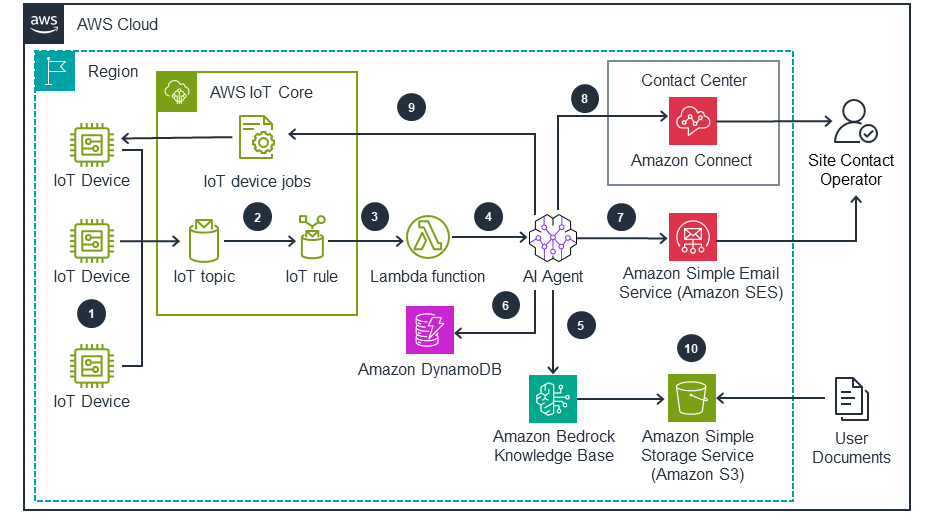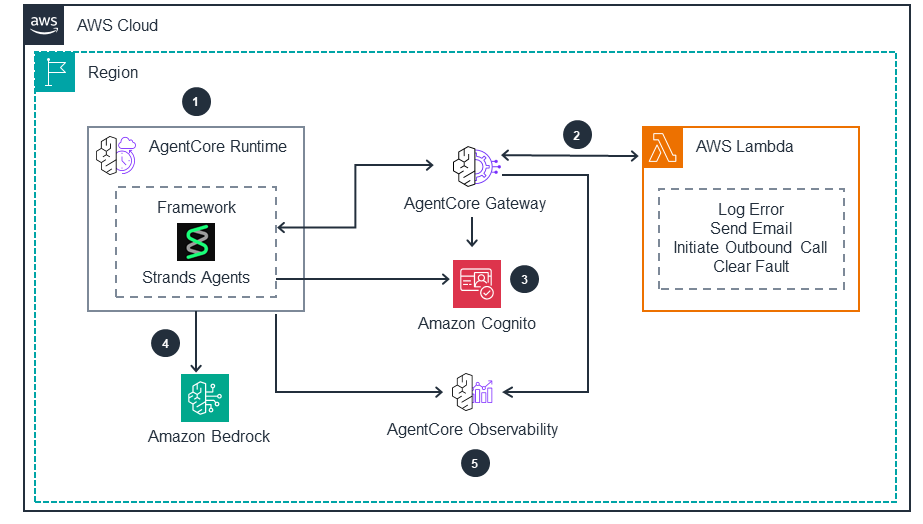- AWS Solutions Library›
- Guidance for Connecting Automated Inputs to Contact Centers on AWS
Guidance for Connecting Automated Inputs to Contact Centers on AWS
Overview
How it works
AI-Powered Automated Incident Detection and Response System Using Bedrock Agents
This AWS guidance demonstrates a comprehensive IoT-to-contact center integration solution that connects automated data sources like IoT devices, IVR systems, and CRM alerts to omni-channel contact centers using artificial intelligence.
.e4814b3ec026d02d70d74762edb6aa21c9292914.png)
AI-Powered Automated Incident Detection and Response System Using Amazon Bedrock AgentCore
This advanced workflow leverages Amazon Bedrock AgentCore Runtime to orchestrate intelligent incident response when IoT devices publish telemetry and error messages to AWS IoT Core

AI-Powered Automated Incident Detection and Response System Using Amazon Bedrock AgentCore (AI Agent Flow)
This architecture diagram illustrates how to effectively support connecting automated inputs to contact centers on AWS. It enables real-time error monitoring and resolution, and seamless contact center integration for IoT-connected systems, reducing downtime and optimizing issue resolution through AI-driven workflows. This slide shows Steps 1-5 for the AI Agent.

Deploy with confidence
Ready to deploy? Review the sample code on GitHub for detailed deployment instructions to deploy as-is or customize to fit your needs.
Well-Architected Pillars
The architecture diagram above is an example of a Solution created with Well-Architected best practices in mind. To be fully Well-Architected, you should follow as many Well-Architected best practices as possible.
This architecture implements comprehensive operational monitoring and automation through multiple layers. Real-time IoT device monitoring is handled through AWS IoT Core, automated processing of alerts and anomalies uses Lambda functions, and intelligent ticket creation and routing is handled by Amazon Bedrock. This approach maintains automated feedback loops to detect, process, and resolve device issues with minimal human intervention, while Amazon CloudWatch provides detailed metrics and logging to enable proactive monitoring and quick troubleshooting.
These services create a fully automated operational workflow that significantly reduces mean time to resolution for device issues, freeing up human operators to focus on more complex matters. The managed nature of these services also reduces operational overhead, allowing the team to concentrate on optimizing application logic and business workflows rather than managing underlying infrastructure.
Read the Operational Excellence whitepaperThis architectural framework incorporates multiple layers of robust security controls. AWS IoT Core provides device authentication and encryption of data in transit. Each individual component operates with the principle of least-privilege AWS Identity and Access Management (IAM) roles, helping to ensure secure service-to-service communication. All data stored within Amazon S3 is encrypted at rest, and access to the knowledge base is strictly regulated. Furthermore, this approach implements secure communication channels between the contact center and automated systems, safeguarding sensitive customer and device data.
Read the Security whitepaperAWS IoT Core provides reliable device communication, featuring automatic retry mechanisms and message persistence. And, this architectural framework incorporates multiple data processing paths, handling real-time alerts as well as batch telemetry processing.
Data is durably stored in Amazon S3, and the knowledge base maintains redundant information to facilitate incident resolution. Furthermore, the automated workflow includes error handling and retry logic at each step, helping ensure this workflow can withstand service disruptions and maintain robust operation.
Read the Reliability whitepaperBy separating real-time processing from batch operations, resource utilization is optimized to support efficient workloads. In addition, real-time alerts are processed immediately through Lambda functions, while telemetry data is efficiently handled through Data Firehose. And through the intelligent routing of issues based on severity and type, critical problems receive immediate attention. Lastly, Amazon Bedrock provides rapid AI-driven decision making for ticket classification and routing.
Read the Performance Efficiency whitepaperThis architecture optimizes costs through efficient resource utilization and automated scaling. The serverless components only incur charges during actual usage, while the pricing model of AWS IoT Core effectively handles large numbers of connected devices. Data storage costs are further optimized through the appropriate use of Amazon S3 storage tiers and lifecycle policies. Additionally, the automated incident resolution reduces operational expenses by minimizing the need for human intervention in addressing routine issues.
This approach minimizes operational costs while maintaining high service levels. The pay-per-use model for serverless components helps ensure that costs scale directly with usage, and the automated workflow reduces human operational expenses. The efficient data handling and storage strategies also optimize the ongoing infrastructure costs.
Read the Cost Optimization whitepaperThe serverless components of this architecture automatically scale to match actual demand, eliminating idle resource waste. This framework also optimizes data storage through the efficient use of Amazon S3 storage tiers and lifecycle policies. Furthermore, the automated incident resolution minimizes the energy footprint by reducing the need for human intervention and associated workplace infrastructure.
This design minimizes the environmental impact through efficient resource utilization and automated scaling. The serverless architecture helps ensure that computing resources are only used when required, while the automated workflow reduces the energy footprint of operational activities. Lastly, the efficient data handling and storage strategies also minimize the infrastructure necessary to maintain the architecture.
Read the Sustainability whitepaperDisclaimer
Did you find what you were looking for today?
Let us know so we can improve the quality of the content on our pages